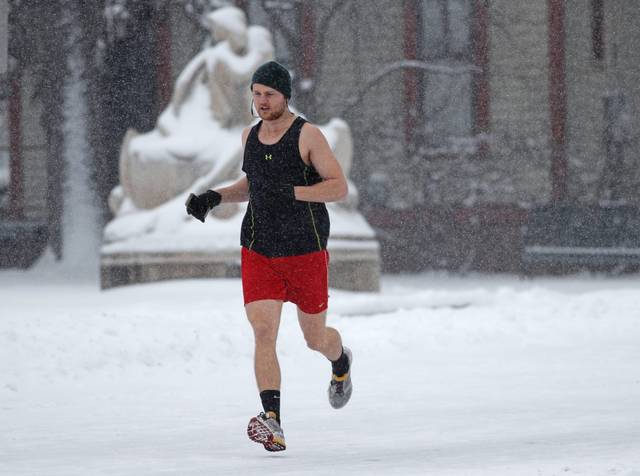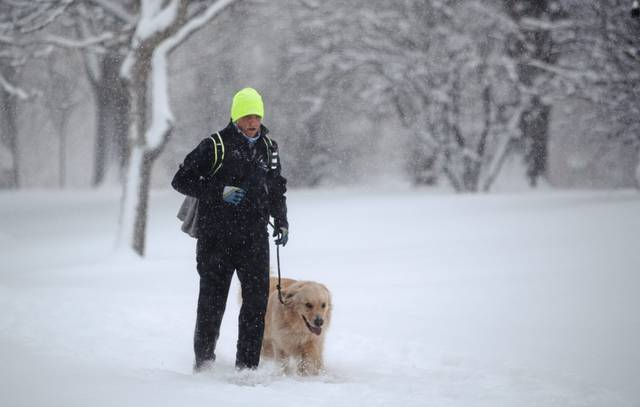Take it outside: Winter exercise is a snap with the right gear
It’s New Year’s Eve — time once again to make a resolution to do something better in the new year.
Starting with Halloween candy, continuing with the Thanksgiving feast and finishing off with holiday indulgences in December, it’s no wonder that many of our resolutions have to do with getting healthier.
One thing that could mean is getting back to a regular exercise routine that’s been neglected in recent months.
And with days getting longer minute by minute as we leave the winter solstice behind, it might also be time to turn off the TV, get off the couch and get outside — even if it’s cold and snowy. There’s nothing like a little fresh air to invigorate body and soul.
But experts say it’s good to get prepared before you rush out into the brisk winter weather. That means making sure you don’t have any underlying health issues that should keep you inside and having the right gear to stay comfortable and safe.
To plunge or not to plunge?
“One thing people like to do after the holidays on the first of the year is the polar plunge,” says Dr. Jim Masterson, director of sports medicine for Excela Health.
Also called a polar bear plunge, the popular event involves jumping into a cold body of water, often on New Year’s Day and often to raise money for charity — or to prove one’s courage or to symbolically wash off the bad habits of the old year and start anew.
“One important thing to do is to have a regular check-up to make sure it’s safe for you to start an exercise program,” Masterson says. That’s especially important before taking a cold-water swim.
“The water is typically 30 to 59 degrees,” he says. “One of the things that people look for is that adrenaline rush they get when their cold receptors are activated.”
“Because skin blood vessels constrict in response to sudden cooling, cold water immersion also causes an instantaneous and massive increase in heart rate and blood pressure. In vulnerable individuals, this greatly increases the danger of heart failure and stroke,” according to coldwatersafety.org.
Though most plungers get in and out of the water quickly, there’s also a risk of hypothermia if they don’t dry off quickly and get into warm clothes or quarters.
Stay safe out there
Even if you pass on the plunge, there are other safety factors to consider before starting an outdoor winter exercise regimen. Here are a few tips from Masterson:
• Test the temp. If the air temperature is below 10 degrees or the wind chill is lower than minus 17 degrees, it’s probably safer to exercise indoors, Masterson says.
• Check your meds. Certain medications — including beta blockers, sedatives and anti-seizure drugs — can increase susceptibility to hypothermia.
Masterson recommends staying away from alcohol during outdoor activity, too. Alcohol dilates blood vessels, increasing blood flow to the body’s extremities. While this causes a sensation of warmth, it actually is exacerbating heat loss.
• Dress for success. Layer your clothing, with a layer of moisture-wicking material next to your skin. Retain heat by keeping your head and hands covered.
• Watch for ice. Fall prevention is paramount to winter safety — concussive injuries are common with falls on ice, he says.
• Stay hydrated. For an hour of exercise, you should replenish your body with 16 ounces of water. If you’ll be at it for more than an hour, think about adding a glucose-containing liquid like a sports drink.
“People tend to only think about hydration in the summertime, but it’s important in the wintertime, too,” Masterson says.
Warm and dry
Once you’re ready to step outside, “it’s all about staying warm and dry,” says Emily Sagun, marketing manager for Fleet Feet Pittsburgh in Bethel Park, a store that stocks athletic shoes, apparel and accessories geared toward runners and also sponsors a running club.
Fabric and fit are the two F’s to keep in mind, Sagun says. From head to toe, it’s best to stay away from cotton, which will stay wet with sweat and trap the moisture next to the skin.
For feet, wool socks will keep you warm and dry and wick moisture away from skin.
A fitted layer made of polyester or merino wool should cover the legs and torso to trap heat next to the body. Think leggings, tights or thermal underwear for the legs and a close-fitting long-sleeved shirt of synthetic material for the torso.
Fleece works well for the middle layer, as does a wool blend. Top it off with a breathable but wind- and water-resistant shell, such as one made from Gore-Tex.
Fleece and wool also are good options for the head and hands. Sagun suggests layering mittens over a pair of close-fitting gloves to keep hands warm and avoid frostbite.
Footwear varies depending on your preferred activity, but strapping on a pair of Yaktrax traction cleats is a good idea if the terrain is icy, she says.
“Dress how you would dress if it was 20 degrees warmer than it is,” Sagun says. “As you move, you warm up.”
That’s another good reason for layering — to shed an outer layer as your workout generates body heat.
No bad weather
As the Scandinavians (who should know) say, there’s no bad weather, just bad clothing. With the proper clothing and safety precautions, Masterson says, outdoor activity should be safe for most people.
Sagun suggests a dynamic warmup before leaving the house, including stretching, skips and kicks.
And if your regular exercise routine took a back seat during the holidays, Masterson says, it’s OK to start slow.
“Just to get out and moving is beneficial,” he says. “There’s benefit in walking 2 miles in a half hour. If you can’t do that, start slow. Do what you can.
“Find something you enjoy. There’s a big difference between forced and enjoyed exercise. If you just hate the cold, find something inside — yoga, Pilates, join a gym,” he says. “Watch the TV or the other people working out as you walk on the treadmill.”
Shirley McMarlin is a Tribune-Review staff writer. You can contact Shirley by email at smcmarlin@triblive.com or via Twitter .
Remove the ads from your TribLIVE reading experience but still support the journalists who create the content with TribLIVE Ad-Free.



